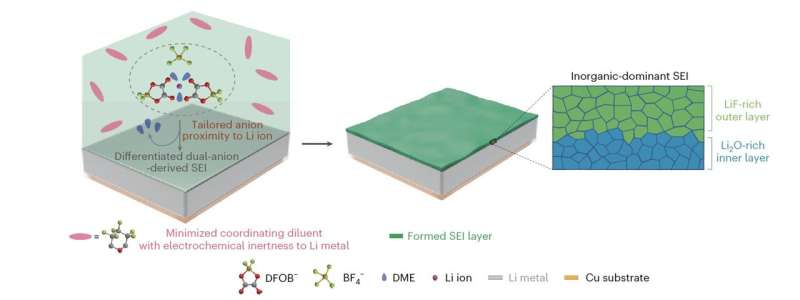May 24, 2024 feature
This article has been reviewed according to Science X's editorial process and policies. Editors have highlighted the following attributes while ensuring the content's credibility:
fact-checked
peer-reviewed publication
trusted source
proofread
Extending the lifespan of lithium-metal batteries using a fluorinated ether diluent

The design of battery technologies with increasingly longer lifespans could help to meet the growing needs of the electronics and automotive industry. Lithium (Li) batteries are the most widely used rechargeable batteries worldwide. Thus, devising strategies that can increase their longevity could be far easier than designing entirely new batteries.
Li-metal batteries, batteries with a Li metal anode, are among the most promising next-generation battery designs. Nonetheless, the reactivity of Li metal has so far greatly limited their cycling stability, by impairing the formation of stable solid-electrolyte interphases (SEIs), ultimately resulting in shorter battery lifespans.
Researchers at the Pennsylvania State University, University of Illinois Chicago and Argonne National Laboratory have recently introduced a new method to extend the longevity of Li-metal batteries. This method, introduced in a paper published in Nature Energy, relies on the use of a highly fluorinated cyclic ether (3,3,4,4,5,5-hexafluorotetrahydropyran, HFTHP), which exhibits a limited reactivity to Li metal ions and can thus improve the stability of formed SEIs.
"Extending the lifespan of lithium (Li) batteries involves managing reactions at the Li anode and stabilizing the solid–electrolyte interphase (SEI) through strategic regulation of the electrolyte composition," Guo-Xing Li, Volodymyr Koverga and their colleagues wrote in their paper. "We synthesized a fluorinated cyclic ether with minimized Li-ion coordination capability and enhanced electrochemical stability. We demonstrated its crucial role in manipulating the SEI formation process by differentiating the contribution of dual anions to the SEI layer."
A crucial difference between the ether they synthesized and previously proposed linear fluorinated ethers, such as BTFE and TTE, is that it exhibits a minimized coordination to Li ions. This facilitates the formation of an inorganic-dominant bilayer SEI in metal-ion batteries, composed of a Li2O-rich inner layer and a LiF-rich outer layer.
This SEI was found to significantly boost the stability and reversibility of Li-metal anodes. The resulting Li-metal battery cells have a remarkably long cycling life, improved self-discharge capabilities and high-temperature performance.
Li, Koverga and their colleagues used the ether to design a liquid electrolyte for Li-metal batteries composed of 1 M LiDFOB and 0.4 M LiBF4 in dimethoxyethane (DME)/HFTHP. They found that their design achieved exceptional results, with an average CE of 99.5% for anode-free Cu||LiNi0.8Mn0.1Co0.1O2 (NMC811) cells and an extended lifespan.
"The developed electrolyte shows remarkable improvement in calendar life and cycling stability of Li (50 µm)||NMC811 (4 mAh cm−2) cells, maintaining 80% capacity after 568 and 218 cycles at room temperature and 60 °C, respectively," the researchers wrote. "Furthermore, our 410 Wh kg−1 prototype pouch cells demonstrate 80% capacity retention for 470 cycles."
The new strategy introduced by this research team could soon inform additional studies, ultimately facilitating the development of new superior liquid electrolytes for high-density Li-metal batteries. Moreover, their work contributes to the understanding of fluorinated ether diluents, highlighting their potential for the development of next-generation battery solutions.
More information: Guo-Xing Li et al, Enhancing lithium-metal battery longevity through minimized coordinating diluent, Nature Energy (2024). DOI: 10.1038/s41560-024-01519-5.
© 2024 Science X Network


















